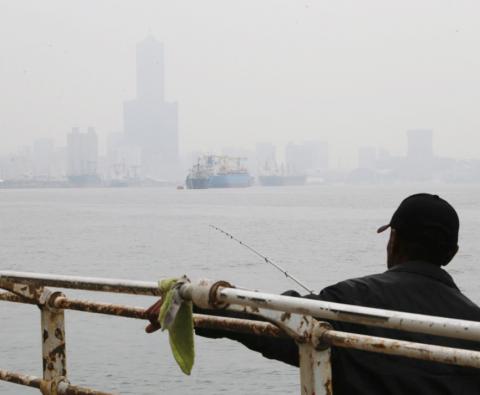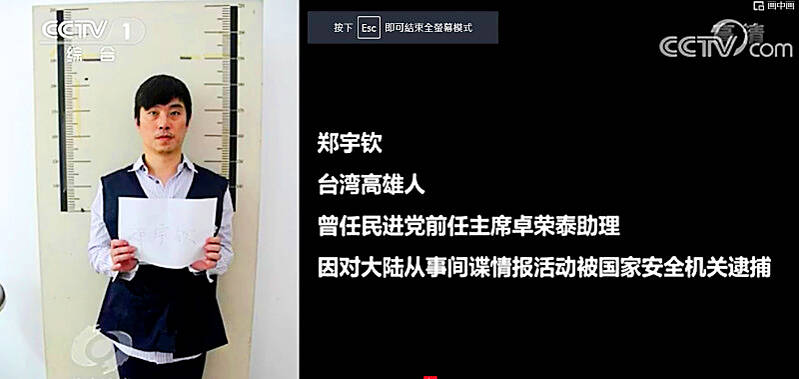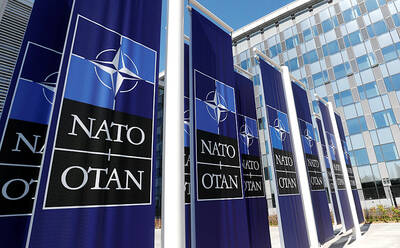Kaohsiung is launching a three-month free public transportation program today to combat the heavy air pollution that often plagues the city at this time of year.
Kaohsiung Mayor Chen Chu (陳菊) at a news conference on Tuesday announced that public transportation will be free for all electronic ticket users.
The program, proposed by the Kaohsiung Environmental Protection Bureau, allows users of electronic tickets, such as iPASS or EasyCard, to take city buses, intercity buses and light-rail trains for free, Chen said.

Photo: CNA
Electronic ticket users can ride the Kaohsiung Mass Rapid Transit (KMRT) system for free on weekdays from 6:30am to 8:30am and from 4:30pm to 6:30pm, she said.
Air pollution in Kaohsiung is particularly severe from December to February, Chen said, adding that the city government has been trying to address the problem by encouraging people to use public transportation.
Bureau Director Tsai Meng-yu (蔡孟裕) said the program is the first of its kind in Taiwan and would cost about NT$200 million (US$6.66 million).
The program could increase ridership on city buses by 1.76 million users, on intercity buses by 70,000 and on the KMRT by 1.6 million, Tsai said, adding that it is projected to reduce carbon dioxide emissions by 16,000 tonnes.
City officials yesterday said that 65 percent of the city’s air pollution comes from overseas, with factories (38 percent), construction sites (24 percent) and vehicles (38 percent) accounting for the remaining 35 percent of pollution that is produced locally.
The bureau said it has managed to control all sources of pollution except vehicles, which is why it was introducing the free public transportation program.
In related news, poor air quality in southern Taiwan is expected to continue into the weekend, the Environmental Protection Administration (EPA) said yesterday, urging sensitive groups to avoid outdoor activities as a precaution.
As of noon yesterday, air quality in the north, particularly in Taoyuan, Hsinchu County and Miaoli County and central Taiwan, had improved significantly from Wednesday, when most of the nation was subject to high levels of PM2.5 — airborne particles measuring 2.5 micrometers or less — the EPA’s Taiwan Air Quality Monitoring Network showed.
The Air Quality Index (AQI) was green (good air quality) or yellow (fair to good) in those areas.
However, the AQI remained orange at six monitoring stations in the south — including Yunlin, Chiayi and Pingtung counties, as well as Tainan and Kaohsiung — meaning that the air quality in those areas remains unhealthy.
A red index was recorded at 12 monitoring stations in those areas, indicating that the poor air quality poses a threat to sensitive groups such as children, seniors and people with heart, respiratory and cardiovascular ailments.
With the red index expected to remain for Kaohsiung and Pingtung until tomorrow, the EPA advised residents in those areas to minimize physical activities if they experience eye irritation, coughing or a sore throat, or to wear a mask when outdoors.
The EPA’s AQI takes into account ozone, PM2.5 and PM10 particulates, carbon monoxide, sulfur dioxide and nitric oxide concentrations in the air.
Additional reporting by Ko Yu-hao

Former Czech Republic-based Taiwanese researcher Cheng Yu-chin (鄭宇欽) has been sentenced to seven years in prison on espionage-related charges, China’s Ministry of State Security announced yesterday. China said Cheng was a spy for Taiwan who “masqueraded as a professor” and that he was previously an assistant to former Cabinet secretary-general Cho Jung-tai (卓榮泰). President-elect William Lai (賴清德) on Wednesday last week announced Cho would be his premier when Lai is inaugurated next month. Today is China’s “National Security Education Day.” The Chinese ministry yesterday released a video online showing arrests over the past 10 years of people alleged to be

THE HAWAII FACTOR: While a 1965 opinion said an attack on Hawaii would not trigger Article 5, the text of the treaty suggests the state is covered, the report says NATO could be drawn into a conflict in the Taiwan Strait if Chinese forces attacked the US mainland or Hawaii, a NATO Defense College report published on Monday says. The report, written by James Lee, an assistant research fellow at Academia Sinica’s Institute of European and American Studies, states that under certain conditions a Taiwan contingency could trigger Article 5 of NATO, under which an attack against any member of the alliance is considered an attack against all members, necessitating a response. Article 6 of the North Atlantic Treaty specifies that an armed attack in the territory of any member in Europe,

LIKE FAMILY: People now treat dogs and cats as family members. They receive the same medical treatments and tests as humans do, a veterinary association official said The number of pet dogs and cats in Taiwan has officially outnumbered the number of human newborns last year, data from the Ministry of Agriculture’s pet registration information system showed. As of last year, Taiwan had 94,544 registered pet dogs and 137,652 pet cats, the data showed. By contrast, 135,571 babies were born last year. Demand for medical care for pet animals has also risen. As of Feb. 29, there were 5,773 veterinarians in Taiwan, 3,993 of whom were for pet animals, statistics from the Animal and Plant Health Inspection Agency showed. In 2022, the nation had 3,077 pediatricians. As of last

XINJIANG: Officials are conducting a report into amending an existing law or to enact a special law to prohibit goods using forced labor Taiwan is mulling an amendment prohibiting the importation of goods using forced labor, similar to the Uyghur Forced Labor Prevention Act (UFLPA) passed by the US Congress in 2021 that imposed limits on goods produced using forced labor in China’s Xinjiang region. A government official who wished to remain anonymous said yesterday that as the US customs law explicitly prohibits the importation of goods made using forced labor, in 2021 it passed the specialized UFLPA to limit the importation of cotton and other goods from China’s Xinjiang Uyghur region. Taiwan does not have the legal basis to prohibit the importation of goods